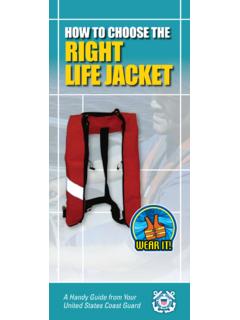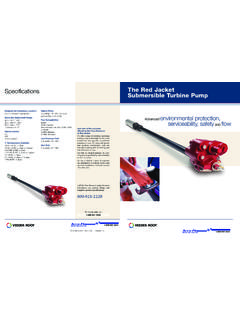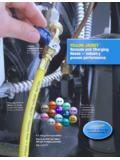Transcription of FR Coating FR Jacket FR Steel Enclosure …
1 Intumescent Coating - Flexible Jacket - Steel Enclosure - Intumescent boardFIREPROOFINGFR CoatingFR JacketFR Steel Enclosure Valve actuator Valve body Cable tray Junction box Air tank Steel structure2 QUALITY CONTROLMOV Limited founded in 1997 is the market leader in manufacturing and supplying engineered fire protection enclosures for valve actuators (Electric & Pneumatic). We also manufacture specialized fire protection boards for Cable Tray and Structural Steel . In addition to our quality products, we provide value-added services including design engineering, fabrication and installation support. We maintain a high ethical and moral standard with regard to our customers, suppliers and employees.
2 Our manufacturing facility is ISO 9001:2008 and ISO 14001: 2004 certified. MOV LimitedPASSIVE FIRE PROTECTION 3 STANDARDS AND TYPES OF FIRESPASSIVE FIRE PROTECTION (PFP)Four Types of Fires are normally FIRE TESTS: The source of thermal energy comes from wood, pulp or paper (cellulose)In a cellulosic fire test the furnace temp rises to 538 C (1000 F) in the first 5 minutes while the typical radiation value is 5 minutes after ignition is 50 kw/m2. The most prominent cellulosic fire time-temp curve comes from International Standards Organization (ISO) R 834. This curve has been adopted by various National and International organizations and is known as ASTM E-119, BS 476, and IMO Resolution AS17(13) and FIRE TESTS: The source of thermal energy is from Petroleum Hydrocarbons, gases and liquids from Petroleum process contrast with Cellulosic fire tests the furnace temperature in a Hydrocarbon fire test rises to 1093 C (2000 F) in the first five minutes.
3 The most prominent Hydrocarbon Fire Tests are known as UL/ANSI 1709, BS 476 Part 20 and FIRE TESTS: The source of thermal energy is hydrocarbon but it is ignited under pressure thereby creating a Jet like flame pattern with high impingement velocityJet fires have turbulent diffusing flames, resulting from the combustion of a steady release of pressurized liquid or gaseous hydrocarbon fuel. These fires present one of the most severe fire scenario that PFP materials are required to withstand, especially considering the effect of thermal shocking and physical matrix disintegration. Thermal Intensity of Jet Fires is high caused by the supply of abundant secondary air and almost optimum fuel / air mix. BLAST OVERPRESSURE TESTS: Boiling liquid expanded vapor explosion (BLEVE) is an example.
4 The overpressure boundary front causes structural damage then the ensuing fire substantially increases the risks to a catastrophic PFP systems are required to withstand the effects of typical hydrocarbon explosions and subsequent blast overpressures. PFP systems selected for this type of environment must have demonstrable explosion resistance that can be supported by relevant testing. Preference should be given to those systems that have been subjected to a dynamic explosion testing by a recognized independent establishment immediately followed by a Hydrocarbon Pool fire test. The PFP manufacturer must certify the maximum acceptable deflection value (straining) of structural members that would not degrade the system s fire resistive fire protection (PFP) is one of the three components of structural fire protection and fire safety of a building structure or process equipment.
5 The other two are Active Fire Protection (AFP) and Active Fire Suppression (AFS). PFP is an insulating system designed to prevent heat transfer from a fire to the structure or equipment being protected. These systems may be made from various materials and prominent among them are spray applied (or fluid cast) coatings / panels made from intumescent epoxy. Other PFP systems may include cementitious insulating panels or fibrous insulation blankets. In many cases PFP systems are used in conjunction with AFP / AFS systems such as water sprays, sprinklers and deluge, foam generation and inert gas FIRE PROTECTIONPFP MATERIALSINTUMESCENT MATERIAL: Materials that provide thermal insulation by means of a barrier char materials are supplied in two distinct forms; either intumescent mastic or thin film intumescent coatings.
6 Intumescent mastics are usually based on epoxy, vinyl or other elastomeric resins and contain an agent that intumesces when exposed to heat. Similar compositions can be cast into panels for creating secure fire Resistive enclosures such as Cable Trays and Valve / Equipment protection Boxes .Intumescence is a complex process in which, when exposed to sufficiently high temperatures, the solid Coating changes phase to a highly viscous liquid. Simultaneously, endothermic reactions are initiated that result in the release of inert gases (with low thermal conductivity). These gases are then trapped inside the viscous fluid where cross-linking reactions take place between the polymer results in the expansion or foaming of the Coating , sometimes up to 8 times the initial thickness, to form a low density, carbonaceous insulation char.
7 This layer of char absorbs a large part of the heat generated by the fire. This endothermic reaction maintains the protected substrates at target temperatures that are within the critical limit established for the specific assembly for specific time Coating continues to react until all its components are used up. In subsequent assessment, the original Coating thickness is established as the target for the required protection mastics are hard and durable and the epoxy resin based products in particular provide exceptional protection from corrosion. This is due to their very high adhesion to the substrate and resistance to impact, abrasion and vibration damage. High tensile and compressive strengths can be obtained and weather resistance is mesh is normally installed to ensure that the material stays in place during the intumescent reaction and to reduce the possible shear stresses along the Coating /substrate mastics are costlier than cementitious products, and skilled operators must carry out the application in carefully controlled , these coatings require more stringent surface preparation than cementitious materials, and their reactivity makes them unsuitable for certain applications, such as enclosed living film intumescents were introduced as early as the 1930 s and are generally solvent or water based single pack coatings.
8 Applied by spray or brush-roller at thickness close to 3mm ( inch). Their fire resistive performance is not as good as Epoxy Intumescent Mastics. Many thin film intumescent coatings are unsuitable for exterior use and test ratings are limited to cellulosic fires only. Advantages of these products include: Availability in a wide range of colors Relatively easier to apply. 5 COMPLIANCE CRITERIA FOR VALVE ACTUATORSFIRE PROTECTION REQUIREMENTS FOR VALVE ACTUATORSThe PFP system is required to be tested at Independent Internationally Recognized Fire Testing Laboratories in accordance with ANSI/UL 1709 methodology. This ensures that the actuators are capable of providing a minimum 30 minutes of endurance (while maintaining circuit / control system integrity) in Petroleum and Hydrocarbon processing facilities both on and off PFP system should provide the valve actuators an endurance period of 30 minutes under UL1709 SOFTWARE3D Modeler Space-E 3D Drawing AutoCAD I AutoDesk InventorGenerally the equipment located in or above the identified fire hazard zones are required to be are.
9 E mergency valve actuators C omponents of valve actuator s electrical system L ocal control panels A ir reservoirs P ower and control cables that pass through the fire hazardous zoneQUALITY CONTROLA Quality Control Manual guides the entire manufacturing and assembly operation. This Manual is a certified document under ISO 9001:2008. Each and every design and manufacturing step is carefully controlled to ensure complete compliance with the Quality Assurance Manual. Our specific steps include (but not limited to): R aw Material inspection and certification P arts list compliance and marking C ross checking of Bill of Materials with Design Drawings a nd othersMOV Limited OPERATIONS6FR COATINGFR Coating ( REMOVABLE / DEMOUNTABLE SYSTEM)ACCESS DOORFR Coating Access door is provided on the pushbutton and lamp for easy T he FR Coating consists of 15mm thick epoxy intumescent pre-cut sections with Steel mesh reinforcement at mid depth.
10 I t is a removable / demountable type of intumescent PFP system. very effective for any kind of valve actuator and equipment. T his product completely eliminates the need for transporting the valve actuator to a faraway assembly location saving substantial logistics costs, project delays and related complexities. F R Coating can be installed onto existing and/or new actuators at site without any modification of the actuator. T he FR Coating is supplied in pre-engineered sections which are then assembled onto the valve actuator in the field. Component sections are attached using Stainless Steel (SS304) bolts. F R Coating may be painted with an approved paint to provide UV resistance and long-term service durability T he pre engineered component sections can be Dis-Assembled to allow for inspection and maintenance and re-assembled to resume safe PFP latest product designed for fire protection of valve actuators, using high performance industry proven intumescent epoxy Coating .







